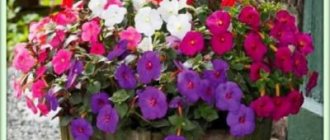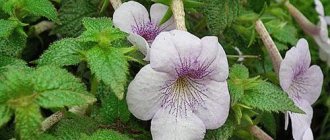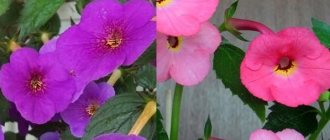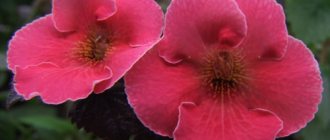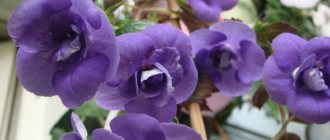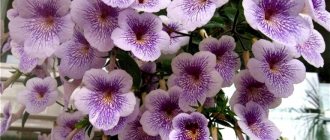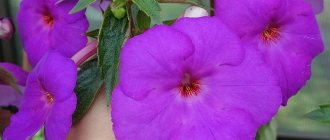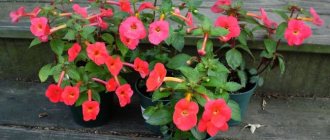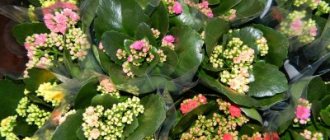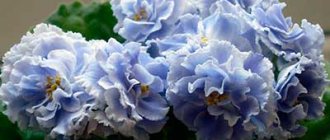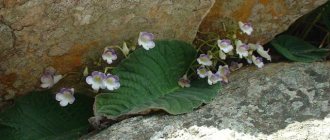According to the type of growth, Achimenes are:
- Erect.
- Ampelous.
- Semi-ampelous.
Achimenes as an indoor flower can grow both straight and in an ampel. In the first case, the branches and shoots grow upward or sideways, and in the second, on the contrary, downward, and the plant sits in special flower pots. The third option is intermediate in terms of the direction of shoot growth.
Flowerpots are flower pots of medium diameter with a special mount for hanging. Such containers are good for climbing or bushy plants. In addition, they perfectly decorate the room without taking up space on the windowsill or table.
The description of the structure of Achimenes should begin with its main advantage - flowers. In shape they are similar to a “pipe” or “gramophone” with different petals - from rounded to “torn” edges. It blooms in summer with white, yellow, pink, purple or blue flowers. There are varieties with spotted, striped or two-colored inflorescences. All appearance features vary depending on the type and variety of the plant.
Classification of Achimenes
All Achimenes are beautiful, but they are extremely heat-loving and die already at a temperature of 14 °C. It is this, as well as the need to maintain rhizomes during the dormant period in special conditions, that restrains their spread in culture.
There is no single classification of Achimenes based on external characteristics. Just like other popular representatives of the Gesneriaceae family.
Varietal and hybrid achimenosyphen are conventionally divided into groups. New cultivars are constantly appearing, which are difficult to limit within the framework of classification.
Description
The main advantage of the culture is its long, magnificent, abundant flowering, which lasts from the end of May to October, which is due to the constant development of new buds.
Funnel-shaped flowers with a long tubular corolla appear from the leaf axils. Their color range is striking in its richness of colors and shades - from beige to inky purple.
Many species feature stunning double flowers, some monochromatic, others two or three colors often with a contrasting colored center. Some breeders classify Achimenes by color group: yellow, pink, purple, white.
The leaves of the plant are heart-shaped, shiny, with jagged edges; in some varieties, the leaves on the reverse side are purple or pink.
In cultivation you can find ampelous varieties with long hanging shoots and a bushy growth form. Slightly pubescent stems grow from underground rhizomes, some of them resemble small scaly pine cones, others are round or pear-shaped.
Botanical description of Achimenes Boehme
According to the botanical description, Achimenes is classified as a member of the Gesnerieceae family. Basically, the genus is represented by perennial herbs with different appearance. Some look like shrubs, others are ampelous with creeping and climbing stems. The plant is native to South and Central America, where it grows in temperate subtropical zones. Most species are found in Mexico.
The rhizome of Achimenes is scaly and consists of rhizomes (deformed shoots). Some gardeners compare root tubers to pink light bulbs because of their similar shape. Achimenes rhizomes are excellent for vegetative propagation. When it is necessary to obtain new specimens, the root is divided into several parts and planted in new places.
The perennial stems are weak. They can be erect or drooping. The branching is weak, but this does not prevent Achimenes from creating beautiful bushes. The leaf blades, covered with small hairs, have a serrated edge. The reverse side of the sheet is painted in a bright color, for example, pink. The foliage is dense and lush, making an excellent backdrop for the tubular flowers during the flowering period.
Flowering occurs in summer. At this time, beautiful tubular buds with a spreading limb are formed. The corolla can have the most unexpected colors - yellow, blue, red, purple and others. Achimenes flowers are formed in the axils of leaf blades, one at a time or in pairs. The corolla is very large with an elegant tube and a 5-lobed cup.
Look at the Achimenes flower in the photo, which shows different forms of growing the plant in home gardens:
Achimenes Sun Wind
In 2010, Serge Saliba presented a beautiful ampelous plant with pale pink flowers, decorated with a bright fringed border and a yellow spot in the center of the corolla. Brown and orange spots are scattered from the center to the edges of the Achimenes petals, as in the photo. This is how the author of the variety represents the solar wind, because this is the name given to Achimenes Sun Wind, which enjoys great love among flower growers.
Peculiarities
Achimenes is a relative of the Uzambara violet (Saintpaulia), belonging, like it, to the Gesnerieceae family. This close relationship largely determines the similarity of the requirements of these plants for conditions of maintenance and care.
Being a representative of the tropical flora of South and Central America, this flower needs comfortable living conditions. However, during the winter dormancy period, Achimenes becomes less demanding, which greatly simplifies its care.
A characteristic feature of this plant is its specific transition to the winter dormancy phase. During this period, the above-ground part of Achimenes dies off, which causes anxiety and even panic among inexperienced gardeners.
Indeed, at first glance, drying and wilting of leaves at this stage can be mistakenly perceived as signs of plant death. However, these processes are completely natural for Achimenes.
After the death of the above-ground part, which the plant gets rid of for economical use of resources, the rhizomes (rhisomes) plunge into a dormant state. With the arrival of spring, the root system wakes up and begins to form new shoots. If you provide the plant with proper care at this time, it can please its owner with abundant flowering twice in just one season.
To date, breeders have developed many hybrid varieties of Achimenes of the most unusual colors and shades. There are varieties with simple and double, large and small flowers.
If the cultivation of indoor achimenes is carried out in accordance with all care requirements, then it enters the first flowering phase in May and can delight with its elegant appearance almost all summer. The second flowering phase usually occurs in late summer and early autumn. At this stage, the plant forms flowers of a smaller size and in small quantities, but this does not at all affect its beauty and decorativeness.
The flowers of this amazing exotic are notable for their funnel- or bell-shaped shape, variegation of colors, richness and variety of shades. The color palette of Achimenes is very extensive. It contains milky white, caramel yellow, pale and dark pink, purple, lilac, carmine red, lilac, light and dark blue tones. Achimenes with two-color striped and speckled flowers are very common in indoor plant growing.
Another important feature of these plants is their relatively long flowering time. Despite the fact that the lifespan of flowers is not very long, they are replaced in a timely manner by new buds. Thanks to this, flowering seems not only long-lasting, but almost continuous.
The most popular among gardeners are the ampelous forms of Achimenes, notable for their creeping and flowing shoots. However, this flower can be grown either erect or cascading.
Achimenes Blue Twice
Achimenes Blue Twice, designed by the famous S.Saliba, appeared much later, only in 2011, but has already become a decoration for many homes. Semi-double or double, not very large flowers of this plant are light blue with a lilac tint. A pattern of veins is visible on the rounded curved petals. There is a picture coating in the center of the rim. The Achimenes bush, as in the photo, is formed from erect shoots with green jagged foliage.
Distinctive features of Achimenes
Indoor flowers Achimenes are relatives of Saintpaulia or Uzambara violet. Decorative culture belongs to the Gesneriev family. Such external similarity requires compliance with all rules for cultivation and care.
Achimenes is native to South America. This type of decorative flower prefers comfortable conditions, thanks to which it blooms profusely and quickly gains leaf mass. During dormancy, the ornamental bush reduces the level of its requirements. To do this, it is enough to water the earthen ball as it dries out.
A characteristic feature of a tropical culture is its specific transition during wintering. At this time, most of the Achimenes quickly die off the leaf mass and the entire ground part. Beginning flower growers begin to panic when such changes occur.
A houseplant, after shedding its ground part, reduces its needs. As a result, its rhizomes have time to store the necessary level of nutrients, which will allow maintaining the ideal state of the exotic crop.
In early spring, new plant parts begin to form. During this period, it is important to provide feeding in a timely manner. Mineral and organic compositions provide vibrant blooms that can be repeated twice in one season.
Breeders have managed to produce a huge number of hybrids. Each variety has its own color and flowering duration. Some varieties have ordinary but bright inflorescences. Others are decorated with terry borders or giant flowers.
New varieties of terry achimenes:
Abendrot. The flowers are yellow in color with a peach tint and are quite large in size.
Abyss. Flowers in shades of dark blue with a light underside.
Adelaide. A hybrid variety with white flowers up to 6 cm in diameter, with yellow and blue splashes on the petals.
Alaska Dream. The corollas are white with a greenish or lavender tint.
Anastasia. Large soft pink flowers with an orange speckled center.
Bianco Natale. It is considered the largest white-flowered terry variety.
Double Picotee Rose. White, densely double flowers with a slight lilac tint. Related varieties: Double Blue Rose, Double Pink Rose.
Christmas Cookie. Large white flowers with a yellow center and pink streaks on the petals.
Cytro. Large pink double flowers.
Icy Volga. The author of the variety considers it an ideal terry achimenes. The flowers are large white, with pink-violet strokes.
Giselle. The corollas are orange-pink in color with a dark spot in the center.
Shy Sun. Lavender-white semi-double flowers. Miniature variety.
Yellow English Rose. Huge bright yellow flowers up to 7 cm in diameter. Shades vary depending on the acidity of the substrate.
Types and varieties
In nature, there are about 25-30 species of Achimenes, which to this day are successfully used by breeders to develop new original varieties. The most popular varieties and types of these plants in indoor plant growing are given below.
- Antirrhina or Entiraina (irregular form of “Antirrhina”) is a lion-headed species of Achimenes, which acquires a very spectacular appearance during the flowering period. Despite the fact that its flowering is not particularly lush, the original appearance of the flowers gives the entire plant an impressive decorative effect. The flowers are small, flounce-shaped, and have finely corrugated edges. The color of the flowers is caramel yellow with a scattering of numerous spots of wine-red color. The leaves are soft, covered with translucent hairs.
- Flava or Flava is a species of very elegant Achimenes, common in indoor plant growing. During the flowering period, the plant is covered with a few lemon-yellow bell-shaped flowers. The spectacular yellowness of the flowers looks very harmonious against the background of soft green pubescent leaves.
- Misera or Misera is a species of achimenes, notable for its creeping shoots with reddish stems. During the flowering period, it forms many small but very beautiful flowers with a light lilac or white corolla and a dark purple spot in the core.
- “Tropical Dusk” is an exclusive and very spectacular variety with medium-sized double flowers. The palette of shades is very diverse and includes caramel pink, light yellow and lavender tones. The diameter of the flowers varies from 3 to 4 centimeters.
- “Nero” is a miniature and compact varietal Achimenes with fantastic double flowers of a rich red hue. The plant is erect, has abundant emerald foliage with carved edges.
- "Sabrina" is a relatively unpretentious variety, notable for its numerous small flowers of pale ruby color and bright yellow center. The diameter of the flowers is on average about 2 centimeters.
- “Anastasia” is a medium-growing variety, characterized by its compact size and proportional formation of the bush. During the flowering period, it forms numerous small flowers of double or semi-double shape of a soft coral shade.
- “Dot” is a luxurious varietal Achimenes, rightfully loved and popular among gardeners for its abundant and long-lasting flowering. During the flowering period, it forms large funnel-shaped flowers of pale lavender color with a dark purple core. It is grown as a semi-ampelic plant, but can also take a bush form.
- “Glory” is a classic variety, notable for its very lush flowering. The simple shape of the flowers is compensated by their abundance and rich, bright ruby color. The diameter of the flowers reaches an average of 3-3.5 centimeters.
- “Nocturne” is a beautifully flowering compact variety that is widely used in indoor plant growing. The plant is notable for its abundance of emerald leaves with a pointed tip and many medium-sized, rich burgundy flowers. It is proposed for cultivation as an ampelous plant, but can also be formed as a bush.
- “Double Pink Rose” is a varietal compact Achimenes that acquires a fantastic decorative effect during the flowering period. During this period, the plant is covered with many double flowers of pale pink color, condensing towards the core. The flowers are medium in size, with petals densely collected in the center. The variety can be grown both as a bush and as an hanging plant.
Achimenes Double Picotee Rose
The plant was bred by G.Mossop, is distinguished by its stable flowering and the fact that, according to the description of Achimenes, the medium-sized flowers stably maintain a bizarre shape. The Double Picotee Rose variety is Achimenes, representing a spectacular family of plants with double flowers reminiscent of a rose. The corollas are white, terry, with thin, barely noticeable lilac tones and veins, which become brighter closer to the throat, giving the flower volume and additional attractiveness. The Achimenes bush, as in the photo, is compact, with bright green foliage and pinkish-brown stems. The same shades are present on the back of the leaves.
Achimenes Boehme: care and cultivation
In order for the bush to develop well and bloom flowers, it is necessary to provide it with certain conditions:
| Factor | Spring Summer | Autumn winter |
| Location | Any window sills, except northern ones, with shading from the midday sun. Take it out onto the terrace or loggia. | Move to a dark, cool closet for winter rest. |
| Lighting | Bright light is needed. Variegated varieties do not tolerate direct sunlight; they need to be shaded. Varieties with dark greens can withstand short exposure to ultraviolet light. | Do not use additional lighting, rest period. |
| Temperature | +22…+23 °С | +15 °С |
| Humidity | 60-65%. You cannot spray the plant itself, only the air around it. You can also pour wet expanded clay into a tray, place a pot on top, or purchase an air humidifier. If water gets on the greens, large dark spots will appear on them. The bush will lose its decorative appearance. | |
| Watering | Abundant, every 3 days. | When the earth dries out. Produce in small portions along the edge of the pot (once a week, 2-3 tablespoons). |
| The water temperature is approximately 2° above room temperature. Make sure that there is no stagnation of moisture. Apply at the root or in a tray, avoiding contact with foliage and shoots. | ||
| Top dressing | 3-4 weeks after the sprouts appear. Subsequent ones - every 2 weeks with mineral fertilizers. | Not necessary. The bush is resting. |
Temperature
For normal development of achimenes, the temperature should not be lower than 20 °C, optimally 22-23 °C. It does not tolerate sudden changes in temperature and cold drafts. In summer, it can be taken out to the balcony only if there are no large fluctuations in daily temperature (cold nights). With the onset of autumn, before the onset of the dormant period, the temperature begins to decrease.
Soil and pot
The soil for planting Achimenes should be loose and light. To make your own soil, you can take leaf soil (3 parts), peat (1 part), sphagnum moss (1 part), coarse sand (1 part). The following substrate is also suitable for achimenes: leaf soil (2 parts), turf soil (3 parts), humus (1 part), coarse sand (1 part). Sand can be replaced with perlite (vermiculite), then the substrate will retain moisture longer.
You can add a little charcoal, mullein and shell rock to the prepared soil mixtures. Ready-made soil is used for planting ornamental flowering plants. The drainage layer should fill one third of the pot.
Achimenes has short roots, so it requires a wide, low container, since in a high pot the soil may begin to sour, which leads to rotting of the root system. For those plants that are grown as hanging plants, use hanging flowerpots.
Rest period
Achimenes has a pronounced dormant period, which lasts about five months. In mid-autumn, the plant ends flowering and growth, the foliage begins to fall and the stems dry out. At this time, stop watering and remove the rhizomes for winter storage. They can be left in the pot and lightly moistened no more than once a month.
There is another storage method: the rhizome is carefully removed from the container and placed in dry peat or sand. In this case, watering is not required. Rhizomes of Achimenes should be stored in a dry place at a temperature of ten to twelve degrees.
If for some reason Achimenes comes out of the dormant period ahead of schedule, you need to provide it with additional lighting so that the sprouts are full-fledged and will grow and bloom well in the future. To do this, you can use fluorescent lamps. And if, on the contrary, the shoots do not appear at the right time, you can awaken the rhizomes by watering them with water heated to fifty to sixty degrees.
Lighting and temperature conditions
Unlike other indoor plants, achimenes are not recommended to be placed in south-facing locations. Intense bright sunlight is permissible only before and during the budding period and subject to shading with tulle curtains. During flowering, such bright light is contraindicated. The flowering plant must be placed at some distance from the window or on a windowsill in the east or west.
But if the shoots and stem begin to stretch out, then the plant does not have enough lighting. In this case, it needs to be placed in a brighter place.
It is also important to know that Achimenes with dark leaves require much more sunlight than specimens with light green and variegated foliage.
The temperature regime also depends on the development cycles of the plant: during the dormant period the temperature should not exceed +15.18 degrees, and during flowering it should be within +22.24 degrees. But a sharp transition from warm to cooler content should not be allowed. This should be done gradually, gradually lowering the temperature. This way the flower will adapt to the cool weather, become stronger and be able to survive the winter safely.
For this purpose, it is placed in a room less warm than living rooms (balcony, veranda, loggia).
Types of indoor Achimenes plants and descriptions of their flowers
According to the type of growth, Achimenes are:
- Erect.
- Ampelous.
- Semi-ampelous.
Achimenes as an indoor flower can grow both straight and in an ampel. In the first case, the branches and shoots grow upward or sideways, and in the second, on the contrary, downward, and the plant sits in special flower pots. The third option is intermediate in terms of the direction of shoot growth.
Flowerpots are flower pots of medium diameter with a special mount for hanging. Such containers are good for climbing or bushy plants. In addition, they perfectly decorate the room without taking up space on the windowsill or table.
The description of the structure of Achimenes should begin with its main advantage - flowers. In shape they are similar to a “pipe” or “gramophone” with different petals - from rounded to “torn” edges. It blooms in summer with white, yellow, pink, purple or blue flowers. There are varieties with spotted, striped or two-colored inflorescences. All appearance features vary depending on the type and variety of the plant.
Caring for Achimenes after planting
Planting a young Achimenes can be done either in a hanging pot or in a regular one. The main thing is not to choose very deep containers; forms with a larger diameter are better suited, as this will saturate the rhizome with oxygen much better. It is worth starting the procedure at the end of February or beginning of March, when the air temperature gradually increases - the cultivation will be successful.
When strong shoots are already sprouting on the rhizome, you should start preparing for planting. To do this, select the healthiest and most overgrown specimens and insert them vertically into the ground. Place the shoots evenly around the entire perimeter of the pot. For a container with a diameter of 10-11 cm - approximately 3-4 rhizomes. Fill in a layer of soil and substrate up to 3-3.5 cm thick.
After planting Achimenes, proper care is required. The most favorable temperature is +22…+24 degrees. And in terms of watering, it is necessary to carefully monitor the soil moisture, preventing it from drying out. Pour warm water over the edge of the pot at least once a week. With proper care, sprouts will appear in about 7-10 days.
If Achimenes flowers are not properly cared for, problems with their health may arise. The plant may be affected by pests and diseases:
- Leaf spotting.
- Aphid.
- Soft-bodied mites.
- Viruses.
The causes of such problems can be watering with cold water, drafts, too much soil moisture, contaminated soil, low temperature, scorching sun rays, and soil lying due to insufficient drainage. To avoid such problems, monitor the growing conditions of your pet, and then it will delight you with its colorful, stunning flowering for many years.
Reproduction of Achimenes
Reproduction of Achimenes, like all Gesnerievs, is possible in different ways, but two are more often used.
Growing Achimenes from seeds
Long way to bloom. At the end of February, fresh seeds are sown superficially. After spraying the soil, the container is covered with film (it is removed for watering and ventilating the seedlings). When shoots appear after 2.5 weeks, the film is removed. When 3 leaves are formed, the seedlings are planted in separate pots. Achimenes will bloom in a year.
Propagation of Achimenes by cuttings
A popular option for propagating rare species. A cutting of at least 5 cm in length is cut from the tops. The lower leaves are removed and placed in warm water with the addition of charcoal powder. In the light, the roots will appear after about 10 days. The rooted cuttings are planted in the ground. Can be propagated by leaf cuttings. The leaf is placed in moistened soil and covered with film. When the roots appear, they are planted in a separate pot. After a few months, the pot is changed to a larger one. If buds appear in the first year, they must be cut off: the task of achimenes at this time is the formation of rhizomes.
Seed propagation leads to the loss of varietal originality of the plant, so it is rarely used.
Diseases and pests
Among the pests, Achimenes is susceptible to infection by aphids, thrips and spider mites. At the first signs of their appearance, it is necessary to treat the plant with an insecticide solution.
Among the diseases the flower is affected by:
- Chlorosis, which occurs when the temperature is not maintained, improper lighting and lack of nutrients. In this case, it is necessary to optimize the conditions for keeping the plant;
- Fungal diseases, such as spotting and various rots, which can affect all parts of the plant. It is necessary to remove the affected areas and treat with a fungicide;
- Bacteriosis, for the treatment of which antibacterial drugs are used.
These diseases are quite difficult to treat, and if they are severely neglected, the plant may die completely. Therefore, it is necessary to regularly carry out preventive examinations of Achimenes and provide proper care for it. Then it will delight you with its bright, charming blooms for a long time.
This video will also help you in caring for Achimenes:
Mistakes and care problems
| Problem | Cause what to do |
| The plant was attacked by pests | We use a special insect repellent. |
| Brown spots on leaves | Water for irrigation is too cold. We use a liquid with a temperature slightly above room temperature. |
| Rot formation | Frequent watering and stagnation of water. The soil must dry out |
| Brown buds | The room is too hot, lower the temperature. |
| Plant drying out | Insufficient water and air humidity |
| Lethargy and yellowness | Need to feed more often. |
Recommendations for purchasing achimenes and its adaptation
There are many places where you can buy achimenes: from flower shops to online stores. Counters and catalogs are full of beautiful flowers. But, unfortunately, not all sellers adhere to an honest policy towards customers. More and more often we come across reports from gardeners about the death of a purchased plant for unknown reasons.
To prevent the purchase of a flowering bush from turning into disappointment, you should adhere to the following recommendations when purchasing:
- You need to buy a flowering plant only with a rhizome. Bushes without rhizomes are not viable. Blooming achimenes is not replanted. It is left in store soil until the planned replanting.
- When purchasing rhizomes in zip bags, you must open the packaging and carefully inspect the contents. Each rhizome must have a growing point. It is better not to buy roots with traces of rot and mold - most likely they will die. It is advisable to purchase already sprouted flowers.
- When purchasing seeds, you should pay attention to the date of manufacture. The fresher the seeds, the greater the likelihood of germination.
After purchase, it is advisable to treat Achimenes with any fungicide. The solution is prepared according to the section on prevention in the instructions for the drug. The best time to purchase new achimenes is spring. Flowers purchased in the fall may die during storage.
You need to understand that this indoor plant requires time to adapt. In order for the flower to quickly get used to its new place, it should be provided with more moisture, heat and light, and also feed the new settler with useful fertilizers.
Popular types with photos and descriptions
The number of species exceeds several hundred. Differences in color, shape or size. But there are the most popular types.
Achimenes grandiflora
Achimenes grandiflora grows in Mexico. The height can exceed 50 cm. Large leaf blades, width - 6 centimeters, length - 10 cm. Flowers grow from the axils of the leaves, red-purple in color. 2 flowers grow from one axil. Blooms from early summer to autumn.
Long-flowered
Long-flowered Achimenes (Achimenes longiflora) is a scaly rhizome. The plant is perennial, herbaceous, about 30 centimeters tall. The shoots are green and have pubescence on the surface. The leaves are oblong with pubescence and a serrated edge. The flowers are purple, large, solitary, growing from the axils of the leaves. There are many varieties and forms. Blooms from April to October.
Mexican
Mexican Achimenes (Achimenes mexicana) has ampelous pubescent shoots up to 40 cm in length. The leaves are dark green above and reddish below. The flowers are wide, reddish-purple with a white throat. Blooms from June to October.
Lion's-eye
Achimenes mexicana (Achimenes mexicana) with medium-sized flowers. The leaves are soft and pubescent. The flowering is not abundant, but the flower itself is very beautiful: painted, with different strokes and stripes.
Tiny
Achimenes tiny or misera (Achimenes Misera). Distinctive features are small flowers up to 1 cm in diameter with a purple spot in the center. The leaves are dark green.
